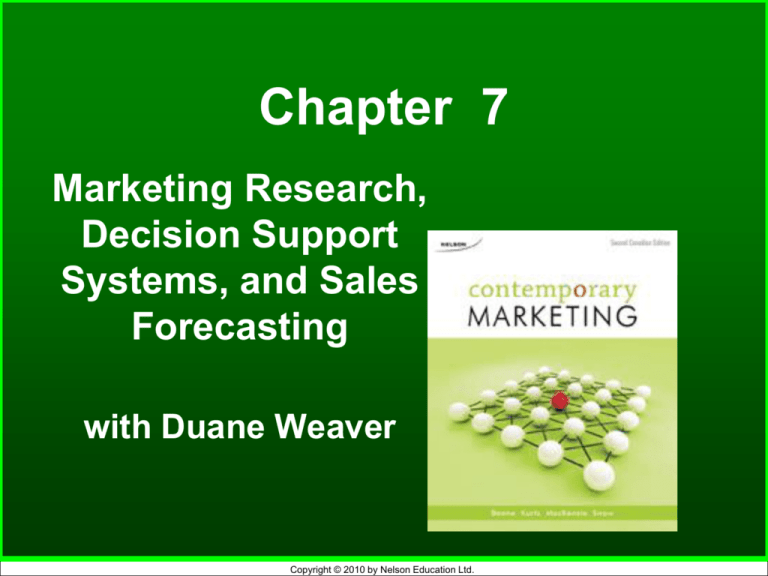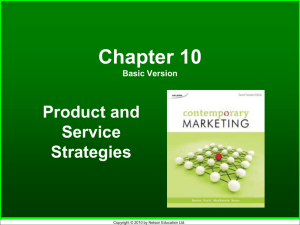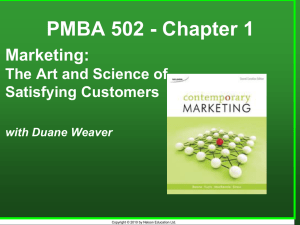Market Research...Chp 7
advertisement

Chapter 7 Marketing Research, Decision Support Systems, and Sales Forecasting with Duane Weaver Copyright © 2010 by Nelson Education Ltd. Chapter Objectives Marketing Research Function 2. The Marketing Research Process 3. Conducting International Marketing Research 4. Computer Technology in Marketing Research 5. Sales Forecasting – Qualitative & Quantitative 1. 7-2 Copyright © 2010 by Nelson Education Ltd. The Marketing Research Function • Marketing research Process of collecting and using information for marketing decisionmaking • Marketers use data from a variety of sources to understand customers, target customer segments, and develop long-term customer relationships • Research is the primary source of information used to make effective marketing decisions 7-3 Copyright © 2010 by Nelson Education Ltd. Who Conducts Marketing Research • The size and organizational form of the marketing research function is typically tied to a given company’s structure • Many firms outsource research needs • Syndicated services– Organizations that regularly provide a standardized set of data to all customers • Full-service research suppliers― Organizations that conduct complete marketing research projects • Limited-service research suppliers― Firms that specialize in selected activities, such as conducting field interviews or performing data processing 7-4 Copyright © 2010 by Nelson Education Ltd. The Marketing Research Process 7-5 Copyright © 2010 by Nelson Education Ltd. Step 1: Define the Problem • Well-defined problems are half-solved • Avoid confusing symptoms with problem itself • Loss of market share is a symptom; reason for the loss is the problem Step 2: Conduct Exploratory Research • Exploratory research Process of discussing a marketing problem with informed sources both within and outside the firm and examining information from secondary sources 7-6 Copyright © 2010 by Nelson Education Ltd. Using Internal Data • • • • Research from past customer surveys and demographic data Sales analysis can compare expected sales with actual sales and be analyzed in a variety of ways, such as by customer type, sales method, and others Accounting data provides information about financial issues Marketing cost analysis evaluates expenses for a variety of costs 7-7 Copyright © 2010 by Nelson Education Ltd. Step 3: Formulate a Hypothesis • • • Tentative explanation for some specific event Sets the stage for more in-depth research Not all marketing research tests specific hypotheses Step 4: Create a Research Design • • Master plan or model for conducting marketing research Must ensure that it will measure what researchers intend to measure 7-8 Copyright © 2010 by Nelson Education Ltd. Step 5: Collect Data • Secondary data (Data from previously published or compiled sources) • Primary data (Refers to data collected for the first time specifically for a marketing research study) Step 6: Interpret and Present Research Information • • • • Present in a format that allows managers to make effective judgments Researchers and end users must collaborate to ensure effectiveness of research Reports must be clear and concise Must explain technical terminology 7-9 Copyright © 2010 by Nelson Education Ltd. Sampling Techniques • Sampling Process of selecting survey respondents or other research participants • Probability: Random, Stratified, Clustered • Non-Probability: Convenience, Quota • • Population (universe) Total group that researchers want to study Census A collection of data on all possible members of a population or universe 7-10 Copyright © 2010 by Nelson Education Ltd. Types of Primary Research 7-11 Copyright © 2010 by Nelson Education Ltd. Conducting International Marketing Research Follow same basic steps as for domestic marketing research • Researchers must be aware of cultural and legal environments • May have to adapt research methods to local conditions • ◦ Example: Focus groups may be difficult to organize in countries where violence and kidnapping are common 7-12 Copyright © 2010 by Nelson Education Ltd. Computer Technology in Marketing Research • • • • • Marketing information system (MIS) Marketing decision support system (MDSS) Data mining Business intelligence Competitive intelligence 7-13 Copyright © 2010 by Nelson Education Ltd. Sales Forecasting • Sales Forecast Estimate of company or product revenue for a specified future period 7-14 Copyright © 2010 by Nelson Education Ltd. Qualitative Forecasting Techniques • These techniques rely on subjective data that reports opinions rather than exact historical data Jury of Executive Opinion • Combines and averages the outlooks of top executives from such areas as marketing, finance, production, and purchasing Delphi Technique • Solicits opinions from several people, but it also gathers input from experts outside the firm rather than relying completely on company executives 7-15 Copyright © 2010 by Nelson Education Ltd. Qualitative Forecasting Techniques (continued) Sales Force Composite • Develops forecasts based on the belief that organization members closest to the marketplace offer the best insights concerning short-term future sales Survey of Buyer Intentions • Gathers input through mail-in questionnaires, online feedback, telephone polls, and personal interviews to determine the purchasing intentions of a representative group of present and potential customers 7-16 Copyright © 2010 by Nelson Education Ltd. Quantitative Forecasting Techniques • This method uses statistical computations such as trend extensions, computer simulations, and economic models Market Tests • Gauges consumer responses to a new product under actual marketplace conditions • Allows researchers to evaluate the effects of different prices, alternative promotional strategies, and other marketing mix variations Trend Analysis • Develops forecasts for future sales by analyzing the historical relationship between sales and time 7-17 Copyright © 2010 by Nelson Education Ltd. Quantitative Forecasting Techniques (CONTINUED) Exponential Smoothing • Sophisticated method of trend analysis that weighs each year’s sales data, giving greater weight to results from the most recent years 7-18 Copyright © 2010 by Nelson Education Ltd. Thank You Utilize market research to your advantage. Databases (in our library) ◦ Euromonitor ◦ GDMI database ◦ Conference Board Financial Sources ◦ SEDAR – Canadian Securities Publically Traded with Annual Reports (competitors too) ◦ Exchanges ◦ All annual reports 7-19 Copyright © 2010 by Nelson Education Ltd.







